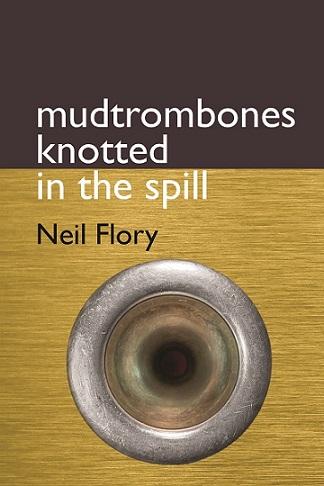

- Christopher Munde
- “a landscape of flesh and pure determination:” A Review of Neil Flory’s mudtrombones knotted in the spill (Arteidolia Press, 2023)

In this book, apprehension only arrives in the wake of ruin: The speaker careens, from the very start, straight through the rippling tension of torn encounters and earth, though, even then, it’s clear the destination will be somewhere other than chaos. Sure enough, Flory’s first poetry collection reveals its intentions early on: The poem “process” demonstrates well the book’s notion that innovation requires self-destruction, and that the very act of moving forward must inevitably involve mourning for the remains of failed, abandoned attempts. In its own way, mudtrombones knotted in the spill is sonder’s choir of anxieties, even when those anxieties lean close to the euphoric. “Communication” develops this worldview further, as it distills the worry inherent in small talk down to the realization that
life
is one big damn glorious
and most incredible improvised
solo[,]
and “was” documents, in halting, splintered lines, erosion and thaw, and casts these as the primary motions in an emotional descent from cohesion into the present. That the present moment would be “slush rivulets open less this to renderless yes” shows that these poems push beyond disillusionment with time’s (and humans’) tampering, and toward an unnerving celebration (and crystallization) of the ever-accruing voices in the landslide.
In this worldview, the pastoral is inverted, with dirt, stone and flora raining from all sides, as though in the aftermath of a gas line explosion. At times, machinery and the delirious natural world tear through one another, like in the excellent opening poem, “beansproutgrasses:"
his fixless suddenly, intuition snap
ping clean steeringwheel sparkplugs battery all
tumblingscreaming teakettle out to cliffs and sea while the wind points
and mocks an acid jig[.]
In other pieces, such as “deadbolt,” the natural world encroaches on (and mimics) the speaker as the latter fumbles with keys and wrestles with the notion of barriers:
The rain continues. The forest, albeit in prime year’s
green, has not moved. His shelter at the edge of it, near/
the road.
[…]
The shining beetle, choosing to stay instead on
this side of the tiny twig. Every scorched inch once again
dissonant this soundless gulf. Closed and locked.
Yet, as a result of this clatter, the effect is ecstatic; terror ascends in rhythmic churn, as (“dissonant”) music invades, even in the form of a pregnant silence, even when the nature of this pregnancy is tumultuous, or uncertain.
So, even without the mudtrombones of the title, and even without the knowledge that Flory is an accomplished composer, it’s clear that music propels the formal choices and guides the book’s content. Portmanteau words (“airslabs,” “kitschbliss,” “subwhisper”), held together by their sonic patterns and their uncomfortable implications, control the rhythm and echo the hefty, double-stressed natural words (“stalwart,” “smoke-wisps,” “shipyard”). Adverbs grasp wildly for verbs, only to then be assailed by a brutalist string of hammering verbs and raw stone. In the poems “salt-grains” and “ears,” onomatopoeia stretches out cacophony like a discordant Russell Atkins. When music makes its way into the content, it often upturns soil and gouges skin, though, at times when narrative cuts through, as in the following excerpt from “flutes,” its instruments perform the same survival work of other items we call instruments:
well if you did decide to go
that way he said I think what
you’d want to do would be to take
these instruments
with you
handing
him four Geiger counters and a flute[.]
It is these moments, plentiful as they are, that allow mudtrombones… to act as an instrument for locating submerged/invisible chaos, and for unraveling and comprehending the consonance in that terror; it is these moments, then, that allow the book to perform as both Geiger counter and flute.
As such, Flory’s “variegated gelatin of uncertainty” (from “not the words”) is endlessly intriguing, and is at its best when it is at its most (formally) concrete; these are the points when the typography refuses easy verbalization, as letters cascade and brackets, parentheses and forward slashes jar the syntax, while nonetheless piecing the fragments into a cohesive, resonant whole. In “vs,” the war between common, conversational phrasing and odd, chipped fragments is riddled with typographical shrapnel:
isn’t
]what we
/split /heavy of he
built ] what we
leviathan /clipped ]forallintents[.]/
It’s also important to note that these poems work so well, in part, because they are sparsely included among the more image-oriented pieces, which allows one the breathing room to engage with this less-than-orthodox material. Pacing, then, is well-handled on both micro and macro scales.
This plunge toward consonance makes mudtrombones knotted in the spill an impressive debut. The role of dissonance in both form and content is always tempered with genuine insight, and leads one, in this rare case in poetry of such kinetic energy, toward cohesion, and a quiet that weighs and expands. Or, as “not the words” demonstrates,
but not the words,
elusive intonation,
enchanting
invocation
of a possibly theoretical
enveloping
equilibrium[.]